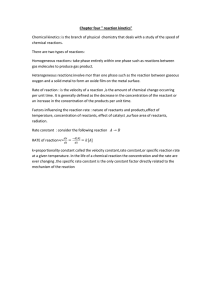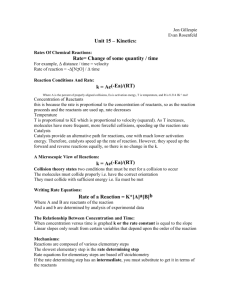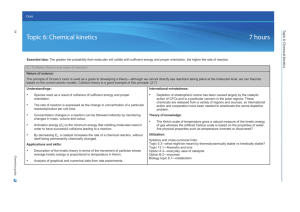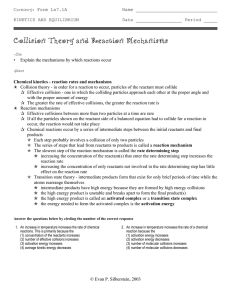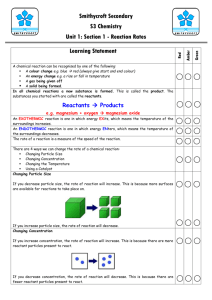CHEMICAL KINETICS (RATES OF REACTION) • increase surface
advertisement
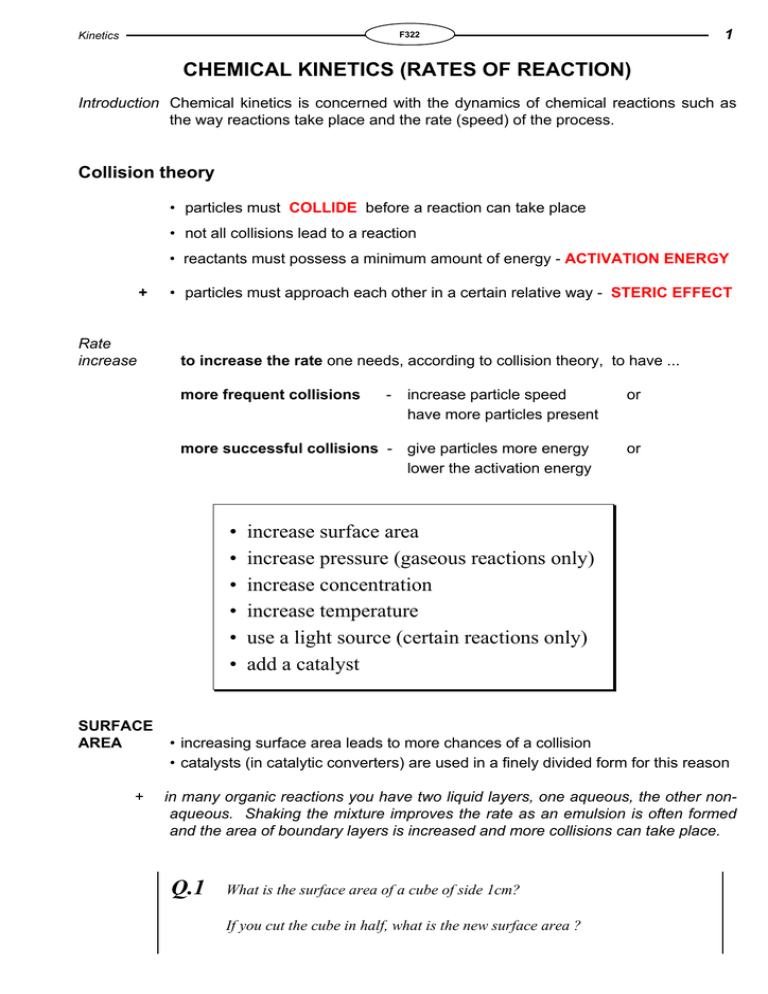
1 F322 Kinetics CHEMICAL KINETICS (RATES OF REACTION) Introduction Chemical kinetics is concerned with the dynamics of chemical reactions such as the way reactions take place and the rate (speed) of the process. Collision theory • particles must COLLIDE before a reaction can take place • not all collisions lead to a reaction • reactants must possess a minimum amount of energy - ACTIVATION ENERGY + Rate increase • particles must approach each other in a certain relative way - STERIC EFFECT to increase the rate one needs, according to collision theory, to have ... more frequent collisions - increase particle speed have more particles present more successful collisions - give particles more energy lower the activation energy • • • • • • SURFACE AREA + or or increase surface area increase pressure (gaseous reactions only) increase concentration increase temperature use a light source (certain reactions only) add a catalyst • increasing surface area leads to more chances of a collision • catalysts (in catalytic converters) are used in a finely divided form for this reason in many organic reactions you have two liquid layers, one aqueous, the other nonaqueous. Shaking the mixture improves the rate as an emulsion is often formed and the area of boundary layers is increased and more collisions can take place. Q.1 What is the surface area of a cube of side 1cm? If you cut the cube in half, what is the new surface area ? © KNOCKHARDY PUBLISHING 2009 2 F322 Kinetics CONCENTRATION Introduction Increasing concentration = more frequent collisions = increased rate LESS CONCENTRATED MORE CONCENTRATED SLOWER FASTER Increasing the concentration of some reactants can have a greater effect than increasing the concentration of other reactants. Reactions start off at their fastest then slow as the reactant concentration drops. In the reaction A + 2B —> C the concentrations might change as shown • the steeper the curve the faster the rate of the reaction • reactions start off quickly because of the greater likelihood of collisions • reactions slow down with time because there are fewer reactants to collide Reactants (A and B) Concentration decreases with time Products (C) Concentration increases with time Concentration eg C [] A B Time • the rate of change of concentration is found from the slope or gradient • the slope at the start of the reaction will give the INITIAL RATE • the slope gets less (showing the rate is slowing down) as the reaction proceeds C concentration in mol dm-3 Rate [] y x gradient = y x Time © KNOCKHARDY PUBLISHING 2009 3 F322 Kinetics PRESSURE • increasing the pressure makes gas particles get closer together • this increases the frequency of collisions so the reaction rate increases • many industrial processes occur at high pressure to increase the rate but it also can affect the position of equilibrium - see Chemical Equilibrium LOW PRESSURE HIGH PRESSURE SLOWER FASTER The greater the pressure, the more frequent the collisions TEMPERATURE Effect increasing the temperature increases the rate of a reaction • particles get more energy so they can overcome the energy barrier • particle speeds increase so collisions are more frequent Distribution of molecular velocities and energies Introduction Because of the many collisions taking place, there is a spread of molecular velocities and energies. Experiments indicated that ... • no particles have zero velocity • some have very low and some have very high velocities • most have intermediate velocities. MAXWELL - BOLTZMANN DISTRIBUTION CURVE Number of particles with a given energy T 0 Significance Energy Ea Ea corresponds to the Activation Energy. The area under the curve beyond this value is proportional to the number of particles with energy greater than Ea © KNOCKHARDY PUBLISHING 2009 4 F322 Kinetics Increasing the temperature alters the distribution; • get a shift to higher energies/velocities • curve gets broader and flatter due to the greater spread of values • area under the curve stays constant- corresponds to the total no. of particles Number of particles with a given energy MAXWELL - BOLTZMANN DISTRIBUTION CURVE T 0 Q.2 Ea Energy Superimpose the curves you get at a higher (T2) and a lower (T1) temperature. The Effect of Temperature on the Rate of a Reaction Rate Explanation • increasing the temperature gives more particles with energy greater than Ea • more reactants can overcome the energy barrier associated and form products • a small rise in temperature can lead to a large increase in rate Temperature © KNOCKHARDY PUBLISHING 2009 Energy Profiles 5 F322 Kinetics During a reaction the energy of the system rises to a maximum, then falls There are two possibilities. EXOTHERMIC REACTION • energy falls below the original value • overall release of energy Ea reactants EXOTHERMIC REACTION H products ENDOTHERMIC REACTION • energy rises above the original • overall absorption of energy Ea ENDOTHERMIC REACTION products H reactants LIGHT • shining a suitable light source onto some reactants increases the rate of reaction • the light - often U.V. - provides energy to break bonds and initiate a reaction • the greater the intensity of the light, the greater the effect Examples • the reaction between methane and chlorine - see organic notes on alkanes • the reaction between hydrogen and chlorine Equation H2(g) Bond enthalpies H-H ............. kJ mol-1 Mechanism + Cl2(g) ———> 436 2HCl(g) 242 Cl-Cl ............. kJ mol-1 Cl2 ——> 2Cl• - - - - - - - - - - - - initiation H2 + Cl• H• + Cl2 ——> ——> HCl HCl + + 2Cl• 2H• H• + Cl• ——> ——> ——> Cl2 H2 HCl - - - - - - - - - - - - termination © KNOCKHARDY PUBLISHING 2009 H• - - - - Cl• propagation 6 F322 Kinetics CATALYSTS Operation • provide an alternative reaction pathway with a lower Activation Energy Number of particles Maxwell-Boltzman Distribution Curve WITH CATALYST 0 WITHOUT CATALYST Ea Ea Energy Lowering Ea results in there being a greater area under the curve showing that more molecules have energies in excess of the Activation Energy • decreasing the Activation Energy means that more particles will have sufficient energy to overcome the energy barrier and react • using catalysts avoids the need to supply extra heat - safer and cheaper • catalysts remain chemically unchanged at the end of the reaction. Energy profile for non-catalysed reaction Each of the steps has a lower activation energy than the single reaction without a catalyst Ea Ea reactants H products Types Homogeneous Catalysts same phase as reactants Heterogeneous Catalysts different phase to reactants © KNOCKHARDY PUBLISHING 2009 Uses 7 F322 Kinetics • widely used in industry where an increase in temperature would result in a lower yield due to a shift in equilibrium (e.g. Haber and Contact Processes) • CATALYSTS DO NOT AFFECT THE POSITION OF ANY EQUILIBRIUM but they do affect the rate at which equilibrium is attained. • a lot is spent on research into more effective catalysts - savings can be dramatic • catalysts need to be changed regularly as they get ‘poisoned’ by other chemicals • catalysts are used in a finely divided state to increase the surface area Catalysts... • allow reactions to take place at lower temperatures • enable different reactions to be used • are often enzymes BETTER ATOM ECONOMY REDUCE WASTE GENERATE SPECIFIC PRODUCTS OPERATE EFFECTIVELY AT ROOM TEMPERATURES • have great economic importance in industry • can reduce pollution SAVE ENERGY REDUCE CO2 OUTPUT POLY(ETHENE) SULPHURIC ACID AMMONIA ETHANOL PRODUCTION CATALYTIC CONVERTERS IN CARS © KNOCKHARDY PUBLISHING 2009 8 F322 Kinetics HETEROGENEOUS CATALYSIS Catalyst is in a different phase to the reactants e.g. a solid catalyst in a gaseous reaction Action • takes place at active sites on the surface of a solid • gases are adsorbed onto the surface • form weak bonds between gas and metal atoms Catalysis is thought to work in three stages as follows ... Adsorption • formation of bonds with surface weakens bonds in gas molecules makes a subsequent reaction easier Reaction • adsorbed gases may be held on the surface increases chances of favourable collisions Desorption • the products are then released from the active sites HARD Hetero = Adsorption + Reaction + Desorption The strength of adsorption is critical ... Too weak little adsorption - molecules will not bond to surface Too strong molecules are held tightly and remain on the surface thus blocking reactive sites and preventing further reaction Just right Rate Catalysis of gaseous reactions can lead to an increase in rate in several ways ... • • • • Format Examples reactants are attracted yet products can leave to open up active sites one species is adsorbed onto the surface so is more likely to undergo a collision one species is held in a favourable position for reaction to occur adsorption onto the surface allows bonds to break and fragments react quicker two reactants are adsorbed alongside each other give a greater concentration • used in a finely divided form increases the surface area provides more collision sites. • mounted in a support medium maximises surface area to reduce costs • Metals Ni, Pt Fe hydrogenation reactions Haber Process • Oxides Al2O3 V2O5 dehydration reactions Contact Process © KNOCKHARDY PUBLISHING 2009 9 F322 Kinetics HOMOGENEOUS CATALYSIS Catalyst and reactants are in the same phase • reaction proceeds through an intermediate species with lower energy • there is usually more than one reaction step • transition metal ions often involved - oxidation state changes during reaction Examples Acids e.g. hydrolysis of esters Gases OZONE in the atmosphere breaks down naturally as follows ... O3 ——> O• + O2 It breaks down more easily in the presence of chlorofluorcarbons (CFC's). There is a series of complex reactions but the basic process is :• CFC's break down in the presence of UV light to form chlorine radicals CCl2F2 • chlorine radicals then react with ozone O3 • chlorine radicals are regenerated ClO• + —> Cl• Cl• + + •CClF2 —> ClO• + O2 O —> O2 + Cl• Overall, chlorine radicals are not used up so a small amount of CFC's can destroy thousands of ozone molecules before the termination stage © KNOCKHARDY PUBLISHING 2009
